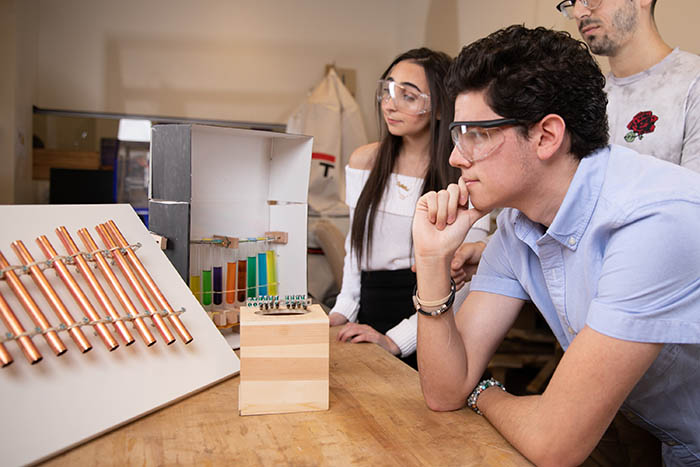
By Lana Sweeten-Shults
GCU News Bureau
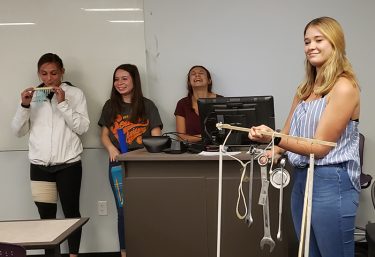
Kaylah Adams took her place behind her church bell xylophone wind chime. She glanced to her bandmates, nodded and then …
ClaaAAANK!!
PING!
Goonggg!!!
The chime spat out a reverberating sound capable of startling living creatures – and did -- when Adams tested the homemade instrument she fashioned out of the “loudest tools that my grandpa had” (mostly wrenches) in preparation for her Science 150 class at Grand Canyon University.
The chatter before her 20-second-long performance, accompanied by fellow GCU science students playing a pan flute made of straws and a thumb piano created out of rake tines, had nothing to do with songs that have a good beat and are easy to dance to.
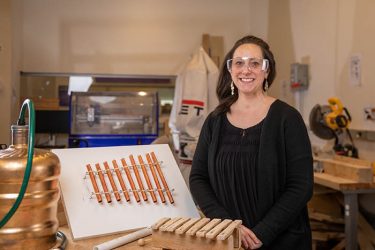
Instead, she and her bandmates – actually, her classmates in Dr. Randy Boyles’ class – displayed data charts that noted the frequencies and wavelengths produced by the instruments they engineered. They gabbed about nodes, antinodes and harmonics.
The musical instrument assignment was just one of the projects students tackled in SCI-150 Critical Analyses in Science, an innovative critical thinking class, not for music majors, but for the College of Science, Engineering and Technology’s prehealth and forensic science students.
About 1,000 students in 13 sections hone their critical thinking skills in the introductory-level course -- a science-focused, critical-thinking-and-analysis boot camp, if you will.
A dozen CSET professors across disciplines in think-tank sessions collaborated to overhaul the course before the fall semester and meet weekly to refine the material under the lead of physics instructor Andrea Strock, who wrote the bulk of the course material, and Dr. Brian Sillanpaa, Assistant Professor of Pathophysiology.
Richard Arum and Josipa Roksa’s landmark book, “Academically Adrift: Limited Learning on College Campuses,” rocked the academic world when it was released in 2011. The authors studied more than 2,300 undergraduates at colleges and universities across the country and found that they improved very little, if at all, when it came to critical thinking.

“As recently as May of 2016, professional services firms PayScale and Future Workplace reported that 60% of employers believe new college graduates lack critical thinking skills, based on their survey of over 76,000 managers and executives.
“Clearly, colleges and universities across the country aren’t adequately teaching thinking skills, despite loudly insisting, to anyone who will listen, that they are,” writes Rob Jenkins in the article “Why College Graduates Still Can’t Think,” published by the James G. Martin Center for Academic Renewal.
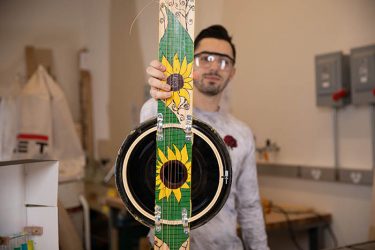
Said Sillanpaa, “I think Dr. Jon Valla (CSET Assistant Dean) and Dr. Bina Vanmali (Sciences Program Director) realized a few years ago that we really needed a critical-thinking course freshman year so we could teach students how to critically think, scientifically reason and analyze, because we want to give them the best opportunity later in their classes. The further they go along in their STEM careers and their classes, the more critical thinking we’re requiring.”
By the time students reach more advanced 300- and 400-level courses, it’s almost 100% case studies, meaning “they have to know how to critically think, first and foremost, among all of their other skills,” Sillanpaa added.
Once students are practicing health professionals in a hospital, for example. Sillanpaa said they have to discern if what a patient is telling them is important or merely an interesting side note. Those critical thinking skills are “not going to be natural to them, and they’re going to struggle.”
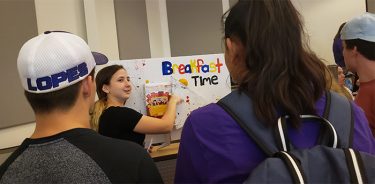
“You see that (struggle) anytime that they have to do anything that involves multiple-step problem-solving later on in their college career,” Strock said. “So we’re trying to help them with that hurdle early.”
Boyles, who teaches biology, genetics, microbiology and exercise science, said the course previously moved in a more traditional fashion through two weeks of biology, two weeks of chemistry and two weeks of physics concepts.
Now faculty members are incorporating concepts from all three of those disciplines concurrently under one theme.
“Bina tasked us with an interesting twist to the class,” Strock said. “She wants it to have a music theme, so we’re running with that. We’re trying to integrate not only biology, chemistry and physics but also music into the curriculum.”
Since SCI-150 casts such a wide net, with students in a variety of majors at various academic levels taking the course (and with varied faculty, too), the theme needed to be something universally relatable.

Using music as a science backdrop seemed perfect.
It is through science, after all, that we know sound is created by vibration and that the frequency of vibration is what makes different sounds.
“Everyone can relate to music,” Vanmali said.
“We have chemists, we have physicists, we have biologists, we have forensic scientists. … I think this is very unique in that there are so many backgrounds even though they’re all STEM,” Sillanpaa said. Those varied backgrounds “give so many great, unique perspectives” to add to the SCI-150 conversation.
Students in the redesigned course delve into more collaborative, hands-on, group-based projects, such as the musical instrument project.
“When I’m teaching, I can honestly say that I don’t go more than 10 minutes at a time of lecturing before it’s, ‘OK, you guys talk about this with each other, come up with some good answers, and then we’ll discuss it as a class,'” Sillanpaa said. “We’re doing a lot of that really research-based pedagogy that you would see in the best K-12 schools.”
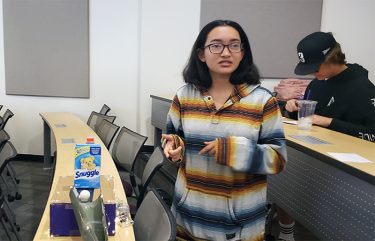
In the musical instrument project, students’ instruments, which they made out of anything they wanted (Strock said they even could go to the Lopes Lab to engineer something), had to produce at least three notes. Not only did students play their instruments but, in their presentations, they spoke about science concepts related to sound, from harmonics to how pitch is related to frequency.
Students even studied the inner, outer and middle ear in lessons leading up to the presentations.
Sillanpaa emphasized that this isn’t the typical middle school project of making a musical instrument for the sake of making a sound.
“It’s much more than that. We want to incorporate the science we’ve been teaching the entire semester,” he said.
Besides musical instruments, students also made their own Rube Goldberg machines. The machines, named after cartoonist Rube Goldberg, perform a simple task but accomplish that task in an indirect, and usually unnecessarily complicated, way.

Students were charged with making their machines out of common household objects. The goal: for the machine to produce a sound.
But the bigger picture, said Strock, is this: “It’s not really about building the Rube Goldberg machine as much as it’s about them thinking through the process of things going wrong – about how they can fix things.”
It was what she emphasized to students in one of her SCI-150 classes: “You guys are going to give us a little intro, tell us about your machine and, probably the biggest thing is, tell us about your process.”
That’s where the critical thinking comes in.
On presentation day, students rotated from project to project, listening to their fellow classmates’ presentations and then evaluating the machines.
Mark De La Fuente presented his team’s “Ding! Gumball” creation – a gumball machine that requires the user to pull a lever that releases a barrier. The gumballs roll past the barrier down a half-tube ramp into a metal bowl to produce the required sound.
One problem the team encountered was that the gumballs flew out of the bowl. The team’s answer: build a backboard onto the bowl.
“An object stays in motion unless acted upon by an external force, right? Just like in basketball, you put up a backboard,” so the bowl needed its own backboard, De La Fuente explained.
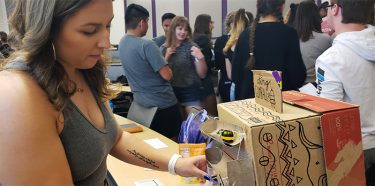
Another complication: making sure the angle of descent wasn’t such that it would lead to a higher probability of the gumballs shooting out of the bowl, De La Fuente said, followed by more physics talk about acceleration and the angle theta.
Teammate Viviana Quiroz, a freshman biology major with an emphasis in prephysician assistant, said the fun of the class is that it’s so hands-on.
“It’s a lot of critical thinking,” added teammate Emma Smith, a freshman forensic science major.
Junior physician assistant major Ryann Agnew said the project required her to think outside the box when creating her team’s marble machine, dubbed The Tear Inducer.
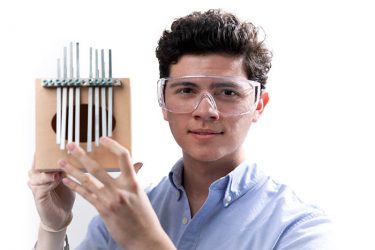
“It made us have to be really creative in ways we’re not used to,” she said. “This is kind of like engineering, having to factor in all the different variables.”
Sillanpaa said students have told him that even though the course is rigorous, SCI-150 has been their favorite course so far at GCU.
Strock reasoned, “I think they like that they get to be part of this scientific community that’s discussing ideas and relevant research. They feel like their voices are heard, even as first-year GCU students.”
“I think it’s because they are actually seeing this is not just information but information we get to talk about. We get to analyze it, we get to apply it,” Sillanpaa said. “It seems to be speaking to them; it seems to be resonating.”
You can reach GCU senior writer Lana Sweeten-Shults at [email protected] or at 602-623-7901.
****
Related content:
GCU Today: New engineering leaders bring industry savvy to GCU















